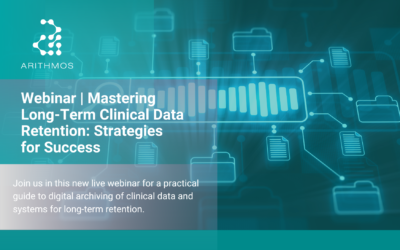We sat down with Antonello Cervone, a computer science and information technology expert with more than 30 years of experience.

He has spent the past 20 years in the pharmaceutical industry, specifically in R&D from both the Sponsor and Vendor perspective and working extensively with CROs, pharma and biotech companies as well as hospitals.
Antonello has recently joined the Arithmos team as a Senior Business and Technical Consultant, leading the implementation of Information Systems and Services across the whole Clinical Research process.
We asked Antonello Cervone about the trending discussion topics on Data Management in Life Sciences.
What do you think about the data management trends in Clinical Research, Antonello?
The role of Data Managers has been changing in recent years, accelerated even more by the pandemic. Now, data management reports and statistics are used to support risk-based metrics to drive effective pro-active study governance (vs prior reactive approach).
Companies have understood this evolution and are investing in digital technology, centralising data with cloud-based clinical metadata repositories and introducing Analytics, Artificial Intelligence and Machine Learning tools.
The goal for the Sponsor is to maximise the value generated from the data with the help of implementing emerging technologies and tools which enable better management and governance of the clinical data.
How do you see the effect of technology adoption by Pharma companies on clinical data governance?
For sure these trends in response to the need to govern clinical data can accelerate clinical trials, and therefore companies can consequently launch new and better drugs, treatments, and devices to improve the healthcare system for patients.
What about the human factor? What are the key elements in improving the skills and capabilities of resources within companies?
People in this field need to be up to date and trained on the new ways to run studies and new technology implementation. Sometimes this means taking some risks but keeping the status quo might be even riskier as it wouldn’t allow companies to grow and be competitive in the market. So, the first key element is being aware that “change is necessary”.
To achieve this objective, companies should support their human resources to develop and reinforce their skills. But we must also be realistic; due to strenuous daily workloads over the existing capacity, such an investment becomes a “luxury” to be carried out in-house, and therefore the only effective alternative is to get external support from experts in the field. Strong partnership networks can help a lot. Companies can benefit from the experience coming from consulting companies specialised in specific technologies.
Companies must also get prepared for the emerging new professionals, such as Data Scientists, who will become the key figures for new technologies such as Artificial Intelligence and Machine Learning.
To what extent is Artificial Intelligence being used in Clinical Research? How can companies get a jumpstart in this area?
In Clinical Research, the statistical analysis has historically been mostly conservative.
For a study, the Health Authorities typically require robust tables and listings with a format that looks as close as possible to the ones defined in the ICH guidelines.
It didn’t exactly encourage the adoption of new analytic tools such as AI-based solutions.
This (partially) justifies the delay in the adoption of AI in the Pharma industry, which is still limited to a few visionary companies.
But this is changing.
The need to speed up study timelines, minimise the number of patients, predict any potential issues/deviations more quickly and, last but not least, reduce costs, has been stimulating the introduction of new analytic tools such as AI.
Of course, not all studies (and companies) are the same. Different study sizes, geographic location spread, unknown diseases and compelling events (e.g. Covid-19) might require different AI solutions.
We also need to keep in mind the resources and budget available in each company.
So, the first thing would be to perform a sort of due diligence to identify such parameters, then look to the market to analyse and choose the solution that best fits such needs.
AI projects can be complex, and therefore selecting an excellent tool that is not adapted to the company needs might result in a total failure.
In my experience, pharmaceutical companies succeed when they work with the right partners to run this assessment.
What about the regulatory aspect?
AI application definitely needs rules. It is not always possible to unveil how an AI system has made a decision or prediction. Therefore, it may become difficult to assess whether a particular action has been taken or identify potential errors and vulnerability to hacking and data privacy breaches.
In 2021, the European Commission published a long-awaited proposal for AI regulation and to harmonise the rules governing AI technologies across Europe. The highest category corresponds to AI tools that contradict EU values and hence should be prohibited. The intermediate category, which corresponds to high-risk AI and comprises medical AI technologies, can be permitted only when the tools comply with specific requirements and obligations for adequate risk management, such as ensuring human oversight and conducting post-market monitoring.
The European Commission proposal for AI regulation is general for all domains of society and does not consider the unique applications and risks of AI in healthcare, contrary to the MDR (Medical Device Regulation) and IVDR (In Vitro Diagnostic Medical Device Regulation) regulations.
Furthermore, the European Commission proposal retains some of the limitations of the MDR and IVDR, such as the lack of mechanisms to address the dynamic nature and continuous learning of medical AI technologies.
For risk identification in AI, several stakeholders have suggested a self-assessment, a structured approach composed of specified checklists and questions.
For example, the independent High-Level Expert Group on Artificial Intelligence (AI HLEG), established by the European Commission, published an assessment checklist for trustworthy AI called ALTAI.
The checklist is structured around seven categories:
1) human agency and oversight;
2) technical robustness and safety;
3) privacy and data governance;
4) transparency;
5) diversity, non-discrimination and fairness;
6) environmental and societal well-being;
7) accountability.
The ALTAI model is general and does not address AI in healthcare specifically. This has motivated the recent development of consensus guidelines for trustworthy AI in medicine by a network of European Commission-funded research projects together with international inter-disciplinary experts.
Entitled FUTURE-AI, these guidelines are organised according to six principles (fairness, universality, traceability, usability, robustness, explainability) and comprised of concrete recommendations and a self-assessment checklist to enable AI designers, developers, evaluators and regulators to develop trustworthy and ethical AI solutions in medicine and healthcare.
What is the status of SME Sponsors when it comes to AI, and what is the common approach?
Small to medium-sized enterprises operating in the pharmaceutical sector are very much interested in the novelty of medical AI, although adoption is typically slowed down by a common risk understanding due to the major challenge of clarity regarding the definition of responsibilities for AI-related medical errors.
Moreover, within small to medium-sized companies, there is often a lack of corporate strategies related to digitalisation, and technological innovation.
Speaking generally, the common approach to AI solutions for healthcare is to provide clinicians with useful indications on the degree of confidence in AI predictions (by integrating uncertainty estimation). Ideally, the clinician should receive alerts/warnings when the uncertainty for predictions is high.
In future settings, the AI system could provide information on the cause for high uncertainty (e.g. low-quality image scans, insufficient evidence in the data), and even advise the clinicians on the course of action needed to improve the AI predictions (e.g. inclusion of additional lab tests and predictors, re-scanning of the patient).
In your opinion, what would be 3 key success factors for clinical data governance?
Based on my years of experience in the sector, the three key factors to successfully govern clinical data can be summed up as follows:
- defining and maintaining Data Standards (following a formal change control process).
- Developing a firm grasp at the corporate level on the various IT systems and services used in the clinical research framework in order to maximise the value of soft assets, reduce organisational risk, and improve the quality of clinical data (including collaboration with Technology Providers). Don’t forget the unstructured Data Repository.
- Implementing advanced analytics technologies to automate processes and improve data quality. Artificial Intelligence and Machine Learning tools can deliver significant time and cost efficiencies while providing better faster insights to inform decision-making.






